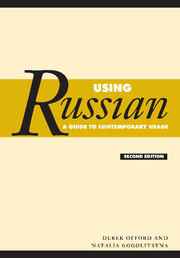Book contents
- Frontmatter
- Contents
- Preface to the first edition
- Preface to the second edition
- Acknowledgements
- Sources
- Note on transcription, stress marks and transliteration
- Glossary of linguistic terms
- List of abbreviations
- 1 Varieties of language and register
- 2 Passages illustrating register
- 3 Problems of meaning: Russian words
- 4 Problems of translation from English into Russian
- 5 Vocabulary and idiom
- 6 Language and everyday life
- 7 Verbal etiquette
- 8 Word-formation
- 9 Inflection
- 10 Prepositions
- 11 Syntax
- 12 Stress
- Index of Russian words, phrases and affixes
- General index
1 - Varieties of language and register
Published online by Cambridge University Press: 05 June 2012
- Frontmatter
- Contents
- Preface to the first edition
- Preface to the second edition
- Acknowledgements
- Sources
- Note on transcription, stress marks and transliteration
- Glossary of linguistic terms
- List of abbreviations
- 1 Varieties of language and register
- 2 Passages illustrating register
- 3 Problems of meaning: Russian words
- 4 Problems of translation from English into Russian
- 5 Vocabulary and idiom
- 6 Language and everyday life
- 7 Verbal etiquette
- 8 Word-formation
- 9 Inflection
- 10 Prepositions
- 11 Syntax
- 12 Stress
- Index of Russian words, phrases and affixes
- General index
Summary
The Russian language and its distribution
The Russian language belongs to the East Slav group of languages, itself part of the Slavonic branch of the Indo-European family. The relationship of Russian to the other modern European languages is illustrated by Figure 1 (which includes only languages still used by substantial numbers of speakers).
It is difficult to give accurate up-to-date figures for the number of people for whom Russian is their native or first language, or at least their first language for some purpose or purposes (e.g. professional or social). This difficulty arises for several reasons. Firstly, we are dealing with several different categories of user, including the following: ethnic Russians who are citizens of the Russian Federation; ethnic Russians who are citizens of other former republics of the Soviet Union; members of other ethnic groups who are citizens of the Russian Federation; and members of other ethnic groups who are citizens of other former republics of the Soviet Union but who continue to use Russian at work or at home, perhaps because their community or family is mainly Russian-speaking. It is not always easy to define whether Russian is the first or second language of at least the latter two groups. Secondly, there has been much migration between the regions and states of the former Soviet Union since the collapse of the Union in 1991, with the result that numbers and proportions of ethnic Russians or other speakers of Russian in each former republic may have changed significantly over the last thirteen years.
- Type
- Chapter
- Information
- Using RussianA Guide to Contemporary Usage, pp. 1 - 31Publisher: Cambridge University PressPrint publication year: 2005



